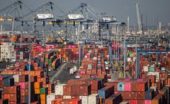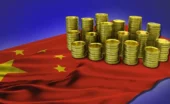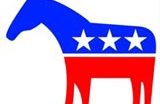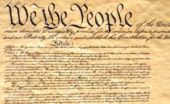Molly Minturn - My family is heartbroken to share that my father died in surgery on Monday, Feb. 10. It…
U.S. Economy March 2025-
Written by Diana Thebaud Nicholson // April 3, 2025 // Economy, U.S. // No comments
What Happens When US Economic Data Can’t Be Trusted?
With Donald Trump firing independent regulators and killing off advisory committees, data on the world’s largest economy may be next.
(Bloomberg) Last week, while many in the US were focused on court orders and secret flights to El Salvador, something else happened that we at Trumponomics think should have gotten more attention. President Donald Trump fired two commissioners on the US Federal Trade Commission—apparently for being members of the Democratic Party
And while firing federal employees—legally or otherwise—is common practice in Trump’s Washington, it’s not supposed to happen at an independent agency—not like this anyway. But if it can happen to officials there, that raises questions about whether folks at other independent bodies, even senior people like Federal Reserve Chair Jerome Powell, could be arbitrarily jettisoned, too.
That in turn made us think about developments in other corners of Washington that are raising red flags about the independence and oversight not only of agencies that implement economic and regulatory policies, but the data itself—data on which the world judges the health of the American economy. US Commerce Secretary Howard Lutnick and Elon Musk have been floating trial balloons on this topic of late. -26 March 2025
Musk, Lutnick Play With Fire When It Comes to GDP
3-4 April
Investors Recoil From Trump’s Pledge to Remake the Global Economy
Stocks hadn’t fallen this far this fast since the early days of the coronavirus pandemic. A 9.1 percent drop in the S&P 500 is the steepest weekly decline since March 2020.
Trump’s tariffs drive economy off a cliff. Thanks, Republicans. You wanted this.
(USA Today)Trump was never shy about his plans. He touted tariffs as if they were a mythical power other American presidents had been too timid to wield.
… Part of the administration’s argument for starting a trade war with these tariffs boils down to this magical thinking: Tariffs will lead to a boom in U.S. manufacturing, which will return America to the glory days of the middle class having good-paying factory jobs.
… Douglas Irwin, a trade expert at Dartmouth College, recently told Bloomberg radio that due to automation, even if factories returned to the United States, “jobs would probably not follow.”
The Trump administration is, simply put, operating ignorantly in a world that no longer exists.
April 2, 2025 (Wednesday)
Heather Cox Richardson
“Never before has an hour of Presidential rhetoric cost so many people so much,” former treasury secretary Lawrence Summers posted
Just five months ago, on October 19, 2024, The Economist ran a special report on America’s economy. That economy was, the magazine said, “the envy of the world.” Today, stock market futures plummeted after President Donald J. Trump announced that he will impose a 10% tariff on all imports to the United States, with higher rates on about 60 countries he claims engage in unfair trade practices, including China, Japan, Vietnam, and South Korea, as well as the European Union.
Dow Jones Industrial Average futures lost more than 1,000 points upon the news, falling by 2.5%; the S&P 500 dropped 3.6%.
Trump’s erratic approach to the economy had already rattled markets, which dropped significantly in the first quarter of this year, and consumer confidence, which recently hit a twelve-year low.
“Never before has an hour of Presidential rhetoric cost so many people so much,” former treasury secretary Lawrence Summers posted. “The best estimate of the loss from tariff policy is now [close] to $30 trillion or $300,000 per family of four.” “The Trump Tariff Tax is the largest peacetime tax hike in U.S. history,” posted former vice president Mike Pence.
Trump claims he is imposing “reciprocal tariffs” and says they are about half of what other countries levy on U.S. goods. In fact, the numbers he is using for his claim that other countries are imposing high tariffs on U.S. goods are bonkers. Economist Paul Krugman points out that the European Union places tariffs of less than 3% on average on U.S. goods, while Trump maintained its tariffs are 39%.
Paul Krugman: Trump Goes Crazy on Trade
“Liberation Day” is even worse than expected
If you had any hopes that Trump would step back from the brink, this announcement, between the very high tariff rates and the complete falsehoods about what other countries do, should kill them.
March 30, 2025
Heather Cox Richardson
On the Fox News Channel this morning, Director of the National Economic Council Kevin Hassett said: “President Trump has a long run vision of a golden age of America and we’re working really, really hard to get it out there in time. But I can’t give you any forward-looking guidance on what’s gonna happen this week. The president has got a heck of a lot of analysis before him, and he’s gonna make the right choice, I’m sure.”
The National Economic Council is the primary group the president uses to develop domestic and international economic policy, so the fact that Hassett appears to have no idea what’s coming is concerning. …
Other Trump regime officials appear similarly uninformed about Trump’s plans. Fox News Channel personality Shannon Bream asked Peter Navarro, Trump’s senior counselor for trade and manufacturing, what to say to consumers who worry that tariffs are going to raise prices, he answered: “Trust in Trump.” He then claimed that “tariffs are tax cuts,” which makes sense only if he means that tariffs, which raise prices on consumers, might provide enough revenue for the government to enable Republicans to justify tax cuts on the wealthy and corporations.
Josh Dawsey and Ryan Felton of the Wall Street Journal reported on Thursday that Trump warned the chief executive officers of “some of the country’s top auto manufacturers not to raise prices because of the 25% tariffs he has just put on cars and car parts, telling them that the tariffs are good for them.
On Saturday, Trump denied he had made such a request and told NBC News’s Kristen Welker that “I couldn’t care less if they raise prices, because people are going to start buying American cars. We have plenty.” A White House aide told NBC News that the president was referring to foreign car prices.
Trump’s Tariffs Set to Make History and Break a System MAGA Loathes
His plans have sparked fears of a US recession and a global slowdown, as well as the end of a post-war order.
By Shawn Donnan, Enda Curran and Maeva Cousin, Bloomberg Economics
He is set this week to impose so-called reciprocal tariffs and other levies on what he has labeled “Liberation Day” — a move expected to cover a broader swath of trade than the infamous 1930 Smoot-Hawley duties that have long served as a cautionary tale about protectionism. It’s part of Trump’s wider project to dismantle the global trading system the US helped build out of that era’s wreckage, on his belief that Americans got a raw deal.
Financial markets are already rattled and officials in world capitals fear the policies could spark a US recession and a global slowdown.
Robert Reich: The shock market
It’s melting down. The consequences?
… To be sure, the stock market is not the economy. The current meltdown isn’t directly affecting most Americans.
Just over half of all the shares of stock owned by Americans are held by the richest 1 percent. Over 90 percent are held by the richest 10 percent.
But the indirect effects of the market meltdown are likely to be felt by most Americans. That’s because the richest 10 percent account for about half of all spending.
…most Americans live in a world in which they cannot pay more than they’re paying now. Most are living paycheck to paycheck as it is.
Tariffs are paid by importers, and importers will pass on as much of the extra costs to consumers as they can.
That’s called inflation.
So it’s frighteningly likely we’ll be heading toward both inflation and recession.
This horrifying combination is termed “stagflation,” and it’s particularly pernicious because the Fed has no clear tools for dealing with it.
The S&P 500 ended the quarter down 4.6%, its worst performance in three years. The Nasdaq 100 posted its worst quarter in nearly three years, down 8.3%, after a pair of warnings last week fanned anxieties about a possible pullback in the hundreds of billions of dollars flowing into data center infrastructure. Making matters worse for the US, the dollar hasn’t been behaving as normal, raising fears that America’s radical policy turns are opening the door for rival currencies to become havens.
Trump’s trade war continues to fuel concern the US economy could stall. Most economists still don’t anticipate America will fall into recession in the next year, but they do say the chance of a contraction has increased. And while many economists have spent the past three years being wrong on recession calls, another worry is the risk that a slowdown in growth will occur alongside accelerating inflation, the dreaded scenario known as stagflation.
Trump’s Science Policies Pose Long-Term Risk, Economists Warn
Since World War II, U.S. research funding has led to discoveries that fueled economic gains. Now cutbacks are seen as putting that legacy in jeopardy
By Ben Casselman
(NYT) President Trump’s tariffs could drive up prices. His efforts to reduce the federal work force could increase unemployment. But ask economists which of the administration’s policies they are most concerned about and many point to cuts to federal support for scientific research.
The Trump administration in recent weeks has canceled or frozen billions of dollars in federal grants made to researchers through the National Institutes of Health, and has moved to sharply curtail funding for academic medical centers and other institutions. It has also, through the initiative called the Department of Government Efficiency, tried to fire hundreds of workers at the National Science Foundation, an independent federal agency. And it has revoked the visas of hundreds of foreign-born students.
To economists, the policies threaten to undermine U.S. competitiveness in emerging areas like artificial intelligence, and to leave Americans as a whole poorer, less healthy and less productive in the decades ahead.
Economists across a broad ideological spectrum argue that investments in scientific research — especially the kind of fundamental, early-stage research that is too risky to attract private investors — are among the most efficient uses of taxpayer dollars. Research has found that every dollar invested in research and development returns about $5 in economic gains, a figure that likely understates the true return because it doesn’t account for benefits that aren’t captured in measures of gross domestic product, like longer lives and increased leisure time.
30 March
Trump’s “Liberation Day” is set to whack America’s economy
A rush of new tariffs will hurt growth, raise prices and worsen inequality
Adam Roberts. Digital editor:
(The Economist today newsletter) …we are looking ahead to a momentous date, April 2nd. Are you set to celebrate “Liberation Day”, as Donald Trump calls it?…Almost no one, of course, will relish the arrival of Mr Trump’s extra tariffs. Even if you thought higher taxes on imports made sense (they don’t), the cavalier way he threatens, imposes and sometimes removes them, is adding uncertainty for all. No wonder stockmarkets, consumer sentiment and other indicators point to a previously roaring economy slowing, perhaps sharply. Mr Trump may not be triggering an outright recession—not yet—but it’s clear that America is set for higher inflation and sluggish growth. Make America stagnate again?
24 March
The Wild Trump Theory Making the Rounds on Wall Street
QAnon for tariffs
By Rogé Karma
(The Atlantic) …have you considered the possibility that [Donald Trump’s tariff policy] is, in fact, the first step of a carefully orchestrated master plan to revive American manufacturing, reduce the national debt, reconfigure the international-alliance system, and deliver the greatest geopolitical deal of the century?
That is the thrust of a new theory that has been gaining currency in Washington, on Wall Street, and in the financial press. The grand bargain that Trump is supposedly planning to strike has even been given a name: the Mar-a-Lago Accord.
19-20 March
Paul Krugman: The Emperor’s New Philosophy Of drunkards, lampposts and economic doctrines
I thought I might weigh in to support and enlarge upon an exceptionally clear post by the always very good Adam Tooze about the commentariat’s sanewashing of Trumpian economic policy.
… My point is that Trump believes many blatantly false things that suit his prejudices. Why imagine that he and his courtiers have sophisticated ideas and a deep strategy when it comes to international economics? On the surface, Trump’s trade policy looks stupid and destructive. Dig deeper, and you discover that this first impression was completely valid. Trying to pretend otherwise is just misinforming readers.
Chartbook 363 Stockholm syndrome in Mar-a-Lago: The belief that “something must be done” and the sanewashing of economic policy in the age of Trump
Adam Tooze
… We ask: who inside MAGA 2.0 is thinking and what are their thoughts? We then relate that to our own efforts to diagnose America’s history and the history of the world economy. At the very least we need to explain how Trump 2.0 happened. Sometimes we will find a match between a strand of policy from inside MAGA and our own analysis and it is tempting to label that as “MAGA for thinking people” and to look for continuities with the Biden team etc. That mode of analysis is reasonable. To historically minded people it is appealing for obvious reasons. But it puts us at risk of is underestimating the radicalism of the break marked by the Trump administration. In search of historical context we miss what is most historically significant. We avoid facing the conclusion that the vision of a Mar-a-Lago Accord may have more in common with grift, a protection racket or a facelift pandering to the ignorant vanity of an old man than with economic policy as we have hitherto known it. Faced with Trump, the risk is that conventional realism is a form of escapism.
Heather Cox Richardson March 13, 2025
The blame for the falling market in the United States today can be laid squarely at the feet of the new presidential administration, with the tariff war it has instigated and the sweeping cuts it has made to United States government employment. President Donald Trump and his staff insist that the pain he is inflicting on Americans will pay off in long-term economic development, but they have deliberately thrust a stick into the wheels of a strong economy.
It is an astonishing thing to watch a single man hamstring the United States economy. It is also astonishing to watch Republican senators try to convince the American people that a falling stock market and contracting economy is a good thing. …
Stocks Tumble Into Correction as Investors Sour on Trump
The S&P 500 is now more than 10 percent below its last record high — a line in the sand for investors worried about a sell-off gathering steam.
11 March
Trumponomics: The Man Behind a Grand ‘Mar-a-Lago’ Plan (podcast)
(Bloomberg) Over just a few weeks, US President Donald Trump has turned the Western security alliance on its head and unleashed a slew of tariff threats (and tariffs) on China, Canada and Mexico (with many reversals and retreats). At the same time, talk has intensified over a so called “Mar-a-Lago accord” named after Trump’s Florida home and aimed at deliberately weakening the dollar. On this week’s episode of Trumponomics, host Stephanie Flanders discusses this with guests Shawn Donnan, senior writer for economics with Bloomberg, and Mark Sobel, the US chairman of the Official Monetary and Financial Institutions Forum. What ties together Trump’s security and tariff bluster? A paper written in November 2024 by Stephen Miran, where the idea of such a deal first appeared. Miran, a former US Treasury official who went on to work as a strategist in the private sector, is now poised to lead Trump’s White House Council of Economic Advisers.
Trump, Bitcoin, and the Future of the Dollar
Carla Norrlöf
(Project Syndicate) By launching new trade wars and ordering the creation of a , Donald Trump is assuming that US trade partners will pay any price to maintain access to the American market. But if he is wrong about that, the dominance of the US dollar, and all the advantages it confers, could be lost indefinitely.
…the US government’s decision to join the reserve-diversification party raises serious doubts about the future of its own currency’s hegemony. If more countries or institutions decide to hold BTC instead of dollars, global demand for dollar reserves could decrease over the long term. Legitimizing a rival store of value may shake confidence in the greenback, eroding America’s global reserve-currency status and the advantages it confers. Without strong international demand for the dollar, the US could ultimately lose its “exorbitant privilege” to print and borrow at low interest rates. Endorsing BTC while defending dollar dominance thus requires a delicate balance.
10 March
US stock market loses $4 trillion in value as Trump plows ahead on tariffs
S&P 500 down over 8% from Feb 19 all-time high
Nasdaq confirmed 10% correction from its Dec peak last week
S&P 500 P/E moderates but still high vs historical average
Delta Air Lines cuts forecast on growing economic uncertainty
Tesla loses more than $125 bln in value in one day
(Reuters) – President Donald Trump’s tariffs have spooked investors, with fears of an economic downturn driving a stock market sell-off that has wiped out $4 trillion from the S&P 500’s peak last month, when Wall Street was cheering much of Trump’s agenda.
A barrage of new Trump policies has increased uncertainty for businesses, consumers and investors, notably back-and-forth tariff moves against major trading partners like Canada, Mexico and China.
The Trump Slump is now
You can’t take a battering ram to every major institution in America and expect the economy to do well
Robert Reich
Corporations are pulling back from investing in new productive capacity — additional jobs, equipment, factories — because Trump’s and Musk’s chaos makes it impossible for them to gauge what the future will bring. Joblessness is rising.
The S&P 500 was down more than 2 percent in [Monday] morning’s trading — after last week’s 3.1 percent drop (the biggest drop in six months) — signaling that investors are spooked.
7 March
Trump’s Crypto Reserve Is Really Happening -Now what?
By Ben Walsh
It’s hard to think of anything that would be less useful for America to stockpile.
(The Atlantic) Yesterday, the president signed an executive order creating both a “Strategic Bitcoin Reserve” and a “Digital Asset Stockpile” made up of different kinds of cryptocurrencies. The bitcoin stockpile, which presumably will be the larger of the two, amounts to “a virtual Fort Knox for digital gold,” Trump said during a crypto summit at the White House earlier today. “‘Never sell your bitcoin.’ That’s a little phrase that they have. I don’t know if that’s right or not. Who the hell knows.”
There are reasons for governments to stockpile essential commodities. America has a Strategic Petroleum Reserve to protect against disruptions in the global oil market or for use during natural disasters or other emergencies. China’s strategic pork reserve helps the government keep prices stable, and South Korea recently had to pull from its strategic cabbage reserve during peak kimchi season. But a crypto reserve would serve none of these functions. The ostensible idea is that stockpiling crypto could help “drive economic growth and technological leadership,” as a fact sheet for the executive order states. But unlike oil or even cabbage, crypto does not serve the core functioning of society. It’s a volatile, highly speculative asset with little proven real-world application that regular old U.S. dollars can’t already account for. It’s hard to think of anything that would be less useful for America to stockpile.
4 March
Mohamed A. El-Erian: US Recession Odds Are Becoming Unsettlingly High
It’s only a matter of time before economists start slashing growth forecasts for the American economy.
(Bloomberg) The notion of a US recession seemed remote just a few months ago, a mere blip on the radar of economic possibilities. More recently, however, that picture has started to change. A downturn, while still a risk scenario, is no longer unthinkable. A confluence of factors, from policy uncertainties to fragile financial markets, is casting a shadow over the world’s largest economy.
Several key financial indicators are already flashing yellow. The yield on 10-year Treasury bonds has fallen about 70 basis points in recent weeks, while oil prices have slipped below $70 a barrel. These moves coincide with a string of disappointing economic data releases, reflecting growing apprehension about the immediate consequences of President Donald Trump’s trade policies and public sector reforms. Indeed, judging from recent surveys, policy uncertainties have already dampened business and household confidence, clouding the economic outlook. This spreading weakness is manifesting itself in three distinct stages.
3 March
Prices rose along border ahead of Trump’s tariffs — now disruption looms
(AP) The prospect of a North American trade war has already thrown the global economy into turmoil, with consumer confidence tumbling, inflation worsening and the auto sector and other domestic manufacturers bracing for a downturn.
Trump dismissed concerns that tariffs are largely paid for by consumers through higher prices, saying: “It’s a myth.”
It is possible for a stronger U.S. dollar to offset some of the costs, but most economic modeling shows tariffs will effectively amount to billions of dollars in tax hikes nationwide. Along the border, the reality is that prices were already rising in anticipation of Trump’s announcement, and much more disruption now looms.
2 March
Trump names cryptocurrencies in strategic reserve, sending prices up
Trump names bitcoin, ether, XRP, solana and cardano for strategic reserve
Bitcoin and ether rise more than 10% on the news
Trump has moved quickly to back crypto industry policy priorities
(Reuters) – U.S. President Donald Trump on social media announced the names of five digital assets he expects to include in a new U.S. strategic reserve of cryptocurrencies on Sunday, spiking the market value of each.
Trump said in a post on Truth Social that his January executive order on digital assets would create a stockpile of currencies including bitcoin , ether , XRP , solana and cardano . The names had not previously been announced.
Trump Announces ‘Crypto Strategic Reserve’
(Forbes) President Donald Trump said Sunday the U.S. will create a “crypto strategic reserve” that includes major cryptocurrencies like bitcoin and ethereum—boosting crypto prices—the latest effort by Trump to court the cryptocurrency industry as he’s become a major crypto backer in recent months.
A national crypto reserve will “elevate this critical industry after years of corrupt attacks” Trump said, adding he directed his administration to “move forward on a Crypto Strategic Reserve” that includes cryptocurrencies XRP, solana and ADA.
He then added a second post saying the reserve will “obviously” include bitcoin and ethereum as the “heart of the Reserve,” saying he “loves” the top two cryptocurrencies.
Trump’s announcement Sunday builds on an executive order Trump issued Jan. 23 directing his administration to create a “working group” to propose a regulatory framework on digital assets, which includes evaluating a “national digital asset stockpile.”



